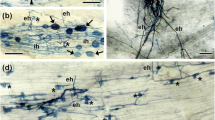Summary
The root nodules ofCeanothus integerrimus were perennial, and after one year they were tightly packed masses of small lobes. Each lobe was root-like in organization and was produced by an apical meristem. Nodule branches were pericyclic in origin. The youngest cells at the tip of the lobes were not infected, and the infection progressed towards the tip with the stage of heaviest infection at the widest part of the lobes. In the areas of uninfected and newly infected cells, there were extracellular actinomycetes which sent branches into young cells. As the actinomycete entered the cell, it induced the host cell to deposit cell wall around it, and this cell wall continued to be deposited as the filament grew within the cell. As the infection progressed, the host cell wall that had been deposited around the invading filament was degraded. At the most heavily infected stages little wall material remained. The plant cell plasmalemma preceded the actinomycete as it entered the cell, and it remained as the membrane separating the actinomycete from the host cell cytoplasm.
Similar content being viewed by others
References
Arzberger, E. G., 1910: The fungous root-tubercles ofCeanothus americanus, Eleagnus argentea, andMyrica cerifera. Miss. Bot. Garden Rep.21, 60–102.
Becking, J. H., W. E. de Boer, andA. L. Houwink, 1964: Electron microscopy of the endophyte ofAlnus glutinosa. Antonie von Leeuwenhoek30, 343–376.
Bond, G., 1974: Root nodule symbioses with actinomycete-like organisms. In: Biology of nitrogen fixation (Quispel, A., ed.), pp. 342–378. New York: American Elsevier.
Bracker, C. E., andL. J. Littlefield, 1973: Structural concepts of host-pathogen interfaces. In: Fungal pathogenicity and the plants's response (Byrde, R. J. W., andC. V. Cutting, eds.), pp. 159–318. New York: Academic Press.
Dijk, C. van, andE. Merkus, 1976: A microscopical study of the development of a sporelike stage in the life cycle of the root-nodule endophyte ofAlnus glutinosa (L.) Gaertn. New Phytol.77, 73–91.
Fletcher, W. W., 1955: The development and structure of the root-nodules ofMyrica gale L. with special reference to the nature of the endophyte. Ann. Bot.19, 501–513.
Gardner, I. C., 1965: Observations on the fine structure of the endophyte of the root nodules ofAlnus glutinosa (L.) Gaertn. Archiv. Mikrobiol.51, 365–383.
—, andE. M. S. Gatner, 1973: The formation of vesicles in the developmental cycle of the nodular endophyte ofHippophae rhamnoides L. Arch. Mikrobiol.89, 233–240.
Gatner, E. M. S., andI. C. Gardner, 1970: Observations on the fine structure of the root nodule endophyte ofHippophae rhamnoides L. Arch. Mikrobiol.70, 183–196.
Goodchild, D. J., andF. J. Bergersen, 1966: Electron microscopy of the infection and subsequent development of soybean nodule cells. J. Bacteriol.92, 204–213.
Käppel, M., undH. Wartenberg, 1958: Der Formenwechsel desActinomyces alni Peklo in den Wurzeln vonAlnus glutinosa Gaertner. Archiv. Mikrobiol.30, 46–63.
Lalonde, M., andR. Knowles, 1975 a: Ultrastructure of theAlnus crispa var.mollis Fern. root nodule endophyte. Canad. J. Microbiol.21, 1058–1080.
— —, 1975 b: Ultrastructure, composition and biogenesis of the encapsulation material surrounding the endophyte inAlnus crispa var.mollis root nodules. Canad. J. Bot.53, 1951–1971.
Pate, J. S., B. E. S. Gunning, andL. G. Briarty, 1969: Ultrastructure and functioning of the transport system of the leguminous root nodule. Planta85, 11–34.
Schaede, R., 1933: Über die Symbionten in den Knöllchen der Erle und des Sanddornes und die cytologischen Verhältnisse in ihnen. Planta19, 389–416.
Silver, W. S., 1964: Root Nodule Symbiosis, I. Endophyte ofMyrica cerifera L. J. Bacteriol.87, 416–421.
Southworth, D., K. Fisher, andD. Branton, 1975: Principles of freeze-fracturing and etching. In: Techniques of biochemical and biophysical morphology (Glick, D., andR. Rosenbaum, eds.), 2, pp. 247–282. New York: Wiley.
Staehelin, L. A., andW. S. Bertaud, 1971: Temperature and contamination dependent freeze-etch images of frozen water and glycerol solutions. J. Ultrastruct. Res.37, 146–168.
Strand, R., andW. M. Laetsch, 1977: Cell and endophyte structure of the nitrogen-fixing root nodules ofCeanothus integerrimus H. and A. I. Fine structure of the nodule and its endosymbiont. Protoplasma93, 165–178.
Torrey, J. G., 1976: Initiation and development of root nodules ofCasuarina (Casuarinaceae). Amer. J. Bot.63, 335–344.
Author information
Authors and Affiliations
Rights and permissions
About this article
Cite this article
Strand, R., Laetsch, W.M. Cell and endophyte structure of the nitrogen-fixing root nodules ofCeanothus integerrimus H.and A.. Protoplasma 93, 179–190 (1977). https://doi.org/10.1007/BF01275652
Received:
Accepted:
Issue Date:
DOI: https://doi.org/10.1007/BF01275652




